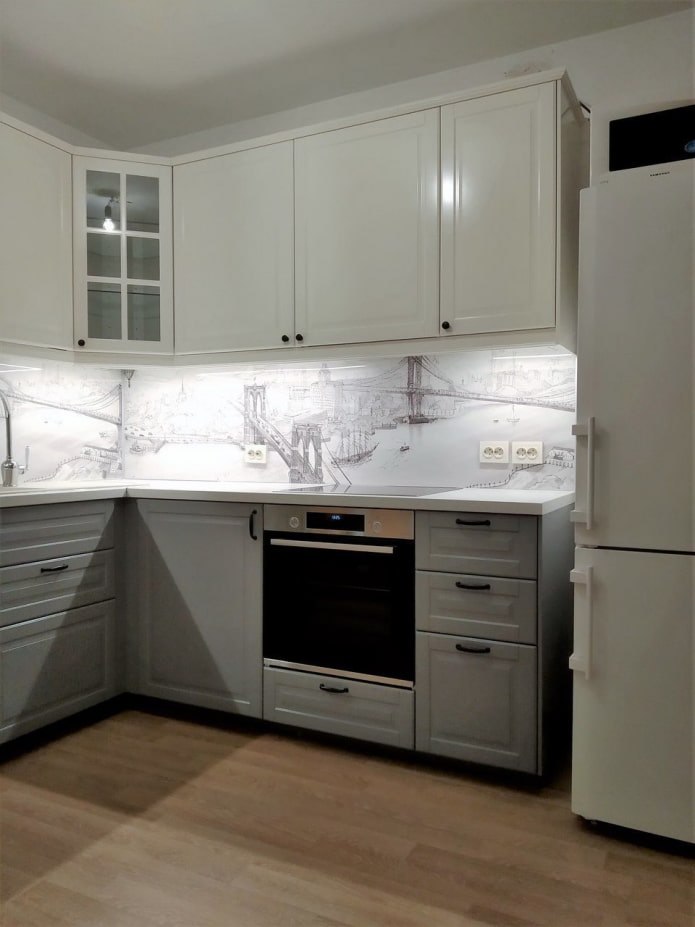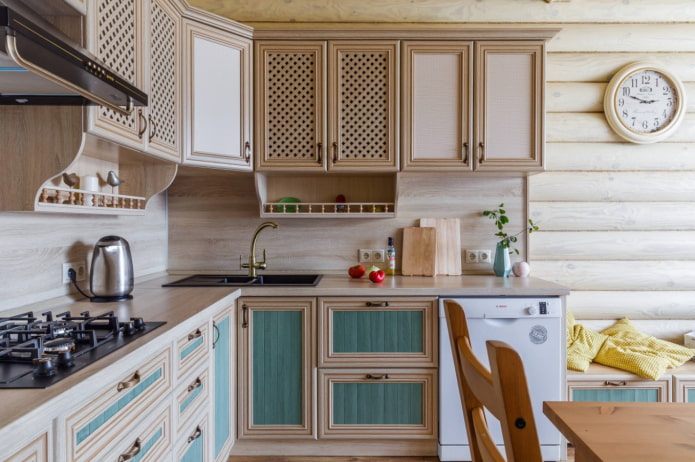Panel characteristics
Before proceeding to a detailed consideration of the use of wall panels, it is necessary to dispel a popular myth.
MDF (medium-density fibreboard) is often confused with chipboard (particle board), while the latter has a reputation for being an environmentally unfriendly material that emits harmful substances (due to glue and resins in the composition). MDF boards, on the contrary, have an environmentally friendly composition: they are produced on the basis of natural wood (wood chips and production waste are ground into dust), and are glued thanks to lignin – a substance produced from wood chips when heated.
The second factor influencing the use of MDF wall panels in the interior is size. Most often, you can find 2 options on sale:
- Rails. Narrow long elements. Their dimensions are similar to plastic ones. Length 2.4-2.8 m, width 20-60 cm, average thickness is 6 mm, but there are also denser ones – 9-14 mm. They are fastened according to the tongue-and-groove principle, like laminate or lining.
- Slabs. Wider and shorter than slats, have the shape of rectangles (length up to 2400, width up to 1500 mm) or squares. They can have a tongue and groove fastening system or smooth edges that are simply joined together (or connected with special elements).

What types are there?
As we have already said, the first difference between MDF wall panels is the form of release. Slatted ones are attached to the wall vertically or horizontally, slab ones can be installed in any order and even assembled into an ornament or pattern, having previously cut them into pieces of the desired shape.
In addition to dimensions, wall panels differ in characteristics. There are:
- Pressed. They are made under high pressure and have a rough uniform surface on both sides. In essence, this is a blank for further work, which can be painted or pasted over independently.
- Waterproof. Suitable for finishing rooms with high humidity – bathrooms, balconies. They differ from the first ones only in the source material and density – no impregnations are added during production (as in chipboard).

The photo shows slatted panels in the bedroom interior


By the method of decorative design, there are:
- Laminated. Just as there is chipboard and laminated chipboard, there are also laminated MDF panels. The basis is a pressed product, onto which a thin film is applied – it makes the coating more durable, protects from water. The film can be of any shade, texture, pattern – from imitation wood to 3D effect, panels with photo printing. Also, depending on the film, wall panels are glossy, matte.
- Veneered. The most natural way of decoration: thin veneer is glued to a sheet of wood, allowing you to achieve the effect of a natural material for almost pennies.
- Painted. A special paint composition is evenly distributed over the surface, allowing you to achieve a smooth texture. The color palette is practically unlimited.
The design of MDF panels is not limited exclusively to the effect on the surface: in addition to flat sheets, you can also find volumetric ones on sale. With the texture of timber, wood, stone, waves, etc.



Pros and cons
Advantages of MDF panels in the interior:
- Environmentally friendly. We have already noted that resins, glue, and other chemical additives are not used in production.
- Decorative. The choice of tones, images, or texture effects, especially for laminated products, is incredibly wide.
- Affordable. The relatively low cost allows you to use MDF even in budget interiors.
- Easy to install. You can install the panels yourself.
- Versatility. Suitable for any style, room – from children’s rooms to bathrooms.
Such an advantage as moisture resistance is not inherent in all products, but the possibility of using MDF panels in damp rooms is still there.
Disadvantages of wall panels:
- Low strength. In terms of impact resistance, wall paneling is inferior even to plasterboard – since the material is quite thin (6-8 mm), it is easy to break through it.
- Reduction in area. The frame + the thickness of the decor itself takes away ~5 cm from each side, which is absolutely unacceptable in small rooms. However, in some cases, MDF is simply glued to the walls, which significantly increases their strength and reduces the space occupied.
- Flammability. Unlike ceramic tiles, for example, even high-quality panels made of fiberboard burn.
Application options
The main ways to use wall panels in interior decoration:
Wall cladding. Rarely are MDF sheets used as a material for the entire room, more often they are used to create accents: for example, to highlight the media area in the living room or the dining area in the kitchen, to decorate the surface behind the bed in the bedroom, or to correct the geometry of the room.
Advice! The slabs can be used to decorate not only the vertical but also the horizontal part of the wall – for example, to make the outline of the room at a level of 80-100 cm from the floor.



Niche processing. MDF panels are suitable for emphasizing the architectural features of an apartment or house, for example, recesses. They can also be used to improve bay windows.
Improving slopes. Ledges, slopes and even doorways look more expensive if they are decorated with wood-fiber material.
Protecting the work surface. One of the frequently used options in the kitchen is MDF aprons. Finished products are 60 cm high – the ideal size for installation between the upper and lower tiers.
Protection is also used in hallways – by attaching MDF panels to the wall in the entrance area, you will simplify your cleaning task. After all, laminated coverings do not absorb dirt, they can be simply wiped with a damp cloth.

The photo shows the finishing of the opening with MDF panels


Design examples
MDF panels in the interior will not look boring if you connect your imagination or resort to ready-made solutions – for example, order custom production.
Interesting options:
- The design of MDF panels imitating wood is a classic. But in addition to wood, they can have other textures: stone, brick, concrete, even leather or matting.
- Using wall panels without a lamination layer allows you to paint them yourself in any suitable color (or order them already painted at the factory). The choice is made according to the RAL palette.

The photo shows a room completely finished with MDF panels


- Thanks to the possibility of photo printing, they replace works of art: you can print any plot, inscription, picture and simply assemble them like a mosaic.
- Cutting out individual parts of fancy shapes from sheet material and assembling them into a decorative panel is another option for “decor without decor”.
- Textured walls with backlighting look impressive – LED strips emphasize the volume of the surface, while simultaneously acting as decorative lighting for the room.

The photo shows decorative wall lighting


How do they look in the interior?
The panels can be mounted in all rooms of the house, including loggias and bathrooms. Let’s consider the application options depending on the functionality of the room.
Bedroom
The wall, open for creativity, is located behind the bed. MDF performs both a decorative and protective function – for example, by placing a bed without a headboard, you can not worry about damage to the wall from constant touching.



Arrange vertically, horizontally, diagonally or create an abstract composition.
Tip! Vertical placement will allow you to achieve the visual effect of a high ceiling, horizontally – to expand the room.

Living room
Here are two options for application, but most often the panels are used to highlight the wall behind the sofa (all or part of it). Just like behind the bed, the panels protect the wall from mechanical damage and have a decorative function.



The second option, beloved by designers, is to highlight the area with the TV. The wires are perfectly hidden in the box used when installing MDF sheets. The result is a stylish media zone.

Kitchen
A functional option for use is an apron, which we have already discussed in the previous sections. An MDF apron can be mounted not only between tiers, but also in a kitchen without upper cabinets – for this, the upper edge is covered with special decorative U-shaped plugs (they also protect the stove from moisture).
A decorative option – accentuating the dining area. The wall in the dining room can be left as is, or supplemented with lighting or decor (paintings, clocks, posters).



In the photo, the apron matches the countertop
Hallway
As in the kitchen, in the hallway, the panels perform both a decorative and functional task. In the first case, they are used to adjust the geometric parameters: you can visually push the walls apart, make the room more square using panels of a darker or lighter shade.
As for functionality, wall slats are indispensable near the front door. They can withstand dirt from boots, scraping from jackets and umbrellas, and blows from bags or strollers.



Bathroom and toilet
Although MDF can be moisture-resistant, it still tolerates temperature and humidity changes worse than plastic or ceramics. Therefore, it should not be used in finishing the walls above the bathtub or in the shower panel. But in a drier part – near the toilet, washing machine, they are irreplaceable.


MDF is a beautiful, practical, but underestimated material. If you are looking for a stylish and easy-to-care-for wall decoration option, take a closer look at this option.






Now reading:
- Tips for arranging furniture in a children’s room: convenient layout and design
- Comprehensive Guide to Buying a Used Opel Insignia
- Kitchen without wall cabinets: 51 photos and the best design solutions
- 10 Creative Ways to Decorate Your Window for the New Year
- 18 Must-Have Indoor Flowers: Photos and Names for Your Home.